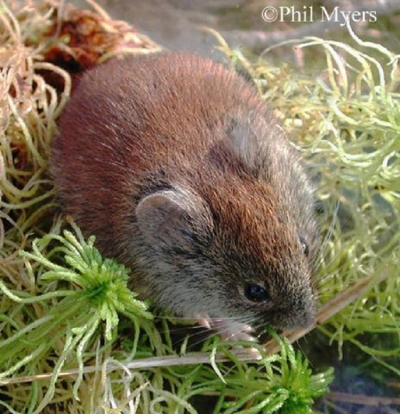Southern Red-back Vole, Myodes gapperi
The Southern Red-backed Vole, which is easily distinguished from the other voles in Tennessee by its reddish back, occurs in east Tennessee.
Description:
A small, stocky rodent with short legs, large head, and small eyes and ears. The back has a broad, reddish or rusty-colored stripe which extends from head to rump. Sides of head and body are gray washed with a buffy color. Belly hairs are black at the base with silver tips. The tail is darker above and lighter below. The summer fur color is darker and duskier than the winter fur.
Length: 4.8 - 6.3 inches
Tail: 1.3 - 2.0 inches
Ears: 0.5 - 0.6 inches
Weight: 0.63 - 1.50 ounces
Similar Species:
Prairie, Woodland, and Meadow Voles, and Southern Bog Lemming all lack broad reddish stripe down the center of their backs.
Habitat:
Prefers cool, moist habitats including forests with moss-covered boulders, wet meadows, and swamps. Unlike other voles, these voles do not build elaborate tunnel systems, but rather use burrows of other animals and natural features like rocks and logs.
Diet:
They primarily feed on herbaceous plants, but will also eat bulbs, tubers, stems, roots, seeds, nuts, berries, lichens, fungi, and occasionally insects.
Breeding information:
Mating usually occurs from late winter to late fall. Females can produce 2-3 litters a year and can breed immediately after giving birth. The gestation period is 17-19 days. Nests are usually built under stumps, logs, or brush piles. Litter sizes range from 2-8, but average size is 4-5 young. The pink, blind, hairless young open their eyes in 12-15 days and are weaned by17-21 days.
Status in Tennessee:
There are no conservation concerns for the Southern Red-backed Vole as they may be common.
Fun Facts:
•Southern Red-backed Voles tend to hop rather than run; they are also very good jumpers and climbers.
Best places to see in Tennessee:
Moist forests with moss-covered rocks.
